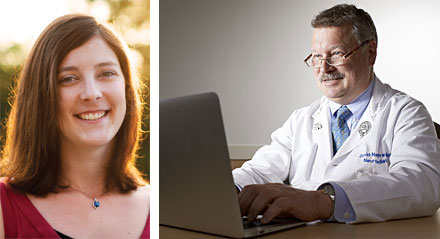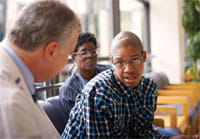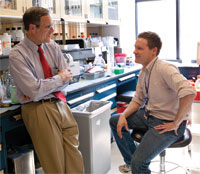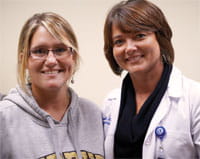Revealing the Power of a Life-Altering Drug for Tuberous Sclerosis Patients
Alyssa Loftus was a baby when she was diagnosed with a rare disease. Little was known about it, and there were very few specialized clinics in the country to serve patients with it.
Since there was no clinic for her in Cincinnati, Alyssa’s parents traveled over 600 miles to take her to the nearest specialist – and he was about to retire.
Concerned, they reached out to David Franz, MD, a young neurologist who had trained at Cincinnati Children’s and was joining the staff. Would he start a clinic for patients with tuberous sclerosis (TS)?
He said yes, and the institution supported the effort.
That was 1992. Today that clinic is the largest, most comprehensive TS clinic in the world. It is transforming care for children and adults with tuberous sclerosis.
“It was a huge leap of faith on the part of Cincinnati Children’s,” says Alyssa’s father, Douglas Loftus. “The whole team’s commitment to creating a better future for kids with TS is just extraordinary.”
Alyssa, now 21, “has gotten the best care available,” her father says, “and it was right here in our backyard.”
Finding Hope
Tuberous sclerosis is a genetic disease that can cause tumors to grow throughout the body – in vital organs, on the skin and in the eye.
Every patient is affected differently. In some, symptoms are mild. In others, they’re severe. Though the TS tumors are not cancerous, they can be devastating and life-threatening. Tumors in the brain can cause seizures, autism and profound developmental delay. Tumors can destroy kidney and lung function.
From the beginning, the Cincinnati Children’s clinic set out to offer a new level of care.
Patients once were isolated, and care was fragmented.
At Cincinnati Children’s, care would be coordinated.
Patients would find lifelong care for all aspects of the disease.
“All the specialties were there, in one clinic,” says Alyssa’s father. “The multidisciplinary approach was a huge benefit.”
In its first 10 years, the program gained recognition for clinical excellence. In its second decade, it became a powerhouse for clinical research.
The Cincinnati Children’s team has led a series of highly successful trials of the first drug that can alter the course of the disease. These studies resulted in rapid FDA approval of the medicine’s use for brain and kidney complications of tuberous sclerosis.
The future is no longer hopeless for patients with TS.
From Gene Discovery to Treatment
New information about the genetics and molecular biology of tuberous sclerosis made this progress possible.
In the 1990s, researchers identified the TS mutation in two genes. By 2000, scientists had discovered that normally these genes control a protein, mTOR, that regulates cell growth throughout the body.
The research to identify the mTOR pathway was done by cancer biologists, but the Cincinnati Children’s TS team seized on the implications for tuberous sclerosis.
In individuals who inherit the TS mutation, mTOR is overactive, causing uncontrolled cell growth and tumors. But there was an existing drug, rapamycin, that inhibits mTOR. The Cincinnati Children’s team reasoned this drug might reduce the growth of tumors in patients with TS.
Their insight opened the door to the first effective treatment.
They began to plan a clinical study of rapamycin and build the necessary infrastructure for the research.
The pilot study tested whether rapamycin could reduce the size of kidney tumors in TS patients and prevent new tumors from growing. It was led by nephrologist John Bissler, MD, the world’s leading expert on the kidney complications of tuberous sclerosis.
As the trial began in 2003, there were doubters.
Dr. Franz recalls, “The drug had been used for transplant and cancer patients. Skeptics asked what made us think it could fix a genetic condition. Some thought it might make the tumors worse.”
Exceeding Expectations
“The families and patients who participated in the trial were more than equal partners in this research,” says Dr. Bissler. “They were courageous and altruistic.”
As a precaution, Dr. Bissler monitored the brain and lungs of study participants for potential harmful side effects of the drug. This led the research in unexpected directions.
One patient enrolling in the kidney trial was found to have a brain tumor. Early results of the kidney study suggested rapamycin was shrinking kidney tumors.
Even though it was thought rapamycin did not penetrate the brain, Dr. Franz wanted to try it. Could it also shrink this patient’s brain tumor? It did – leading Dr. Franz and colleague Darcy Krueger, MD, PhD, to launch a study of TS patients with brain tumors.
While monitoring patients’ lungs, Dr. Bissler found that those with a dangerous lung disease – lymphangioleiomyomatosis (LAM) – showed improved lung function. LAM affects up to 40 percent of women with TS. Could rapamycin help them and others with LAM? A third trial was launched, led by pulmonologists Frank McCormack, MD, from the University of Cincinnati, and Bruce Trapnell, MD, from Cincinnati Children’s.
The rare combination of wide-ranging expertise in one institution, along with a commitment to clinical research, made it possible for Cincinnati Children’s to lead simultaneous trials for kidney, brain and lung.
In each case, results exceeded expectations.
Finally, an Approved Drug Therapy
Results of all these trials have been reported at professional meetings and in major medical journals, beginning in 2006 when Dr. Franz published data for the first five patients with brain tumors to be treated with rapamycin. Tumor size decreased in all patients.
Results of a two-year study of patients with kidney tumors, LAM or both were reported in 2008. Participants received the medicine for a year, followed by a year without it. The medicine reduced the size of kidney tumors in all participants. When it was stopped, tumors grew again in most patients. Of those with LAM, 70 percent had improved lung function that was partially sustained even after the medicine was stopped.
These initial findings supported the idea that inhibiting mTOR is an effective treatment, and led to larger follow-up studies.
Dr. Bissler organized a placebo-controlled trial of kidney tumors. The national TS Alliance spread the word that Cincinnati Children’s was recruiting participants. 118 patients in 11 countries enrolled.
Dr. Franz recruited 28 patients at Cincinnati Children’s for a larger-scale brain tumor study. Alyssa was the 17th to enroll. She had developed a tumor that was rapidly growing and was facing the possibility of a very difficult brain surgery. After six months on the medicine, the tumor had shrunk 50 percent. In fact, tumors shrunk in all 28 patients. None required surgery for brain tumors after treatment. Of those with active epilepsy, 86 percent had seizures less often.
These results were reported in 2010. The FDA responded by granting accelerated approval of the drug for TS patients with brain tumors, while requiring a larger study.
This next, placebo-controlled trial involved 117 patients at centers in the US, Canada and Europe. The outcome, reported at professional meetings in 2011 and published in 2012, confirmed the robust results of the initial study.
A larger-scale LAM study was coordinated through a consortium of 13 institutions around the world.
The findings, published in 2011, showed that the drug stabilizes lung function and improves patients’ quality of life. In 2012, a citizen’s petition requesting accelerated approval of the drug for treating LAM was filed with the FDA. Meanwhile multicenter research to confirm the study results are in progress.
Dr. Bissler presented outcomes of his international follow-up study in February 2012. Kidney tumors shrunk in all patients who received the drug. 42 percent of patients experienced a 50 percent reduction in tumor size. In April 2012 the FDA responded to the data by granting expedited approval of the drug for non-cancerous kidney tumors in TS patients.
Within hours, Dr. Bissler started receiving calls from patients around the world wanting to come to Cincinnati Children’s for care.
Transforming Lives
The outcome of these clinical trials has been transformational for patients and extraordinarily gratifying for the doctors and nurses who work closely with them. “I have the best job in the world,” says Jo Coombs, RN. “We see truly amazing effects of this drug. It changes lives.”
Says Dr. Bissler, “The families and patients inspire us. It’s deeply gratifying that now we can actually do something that gives them hope for the first time.”
“I get passionate when I talk about it,” Doug Loftus acknowledges. “Alyssa would not have the life she has today if it were not for Cincinnati Children’s.”







